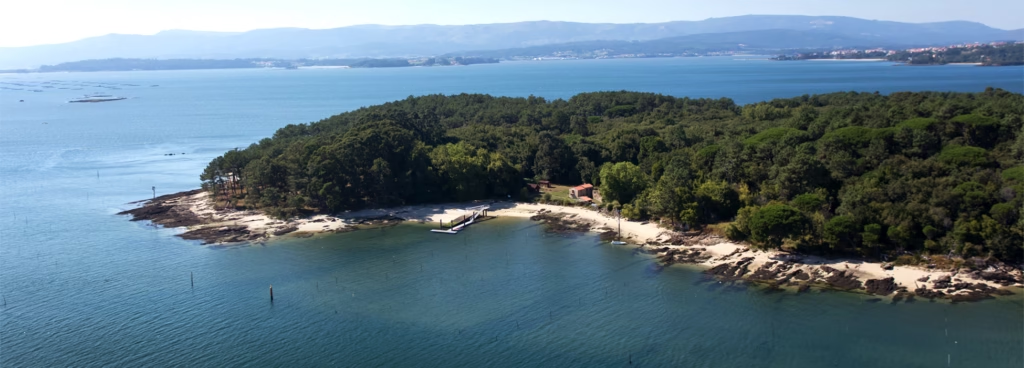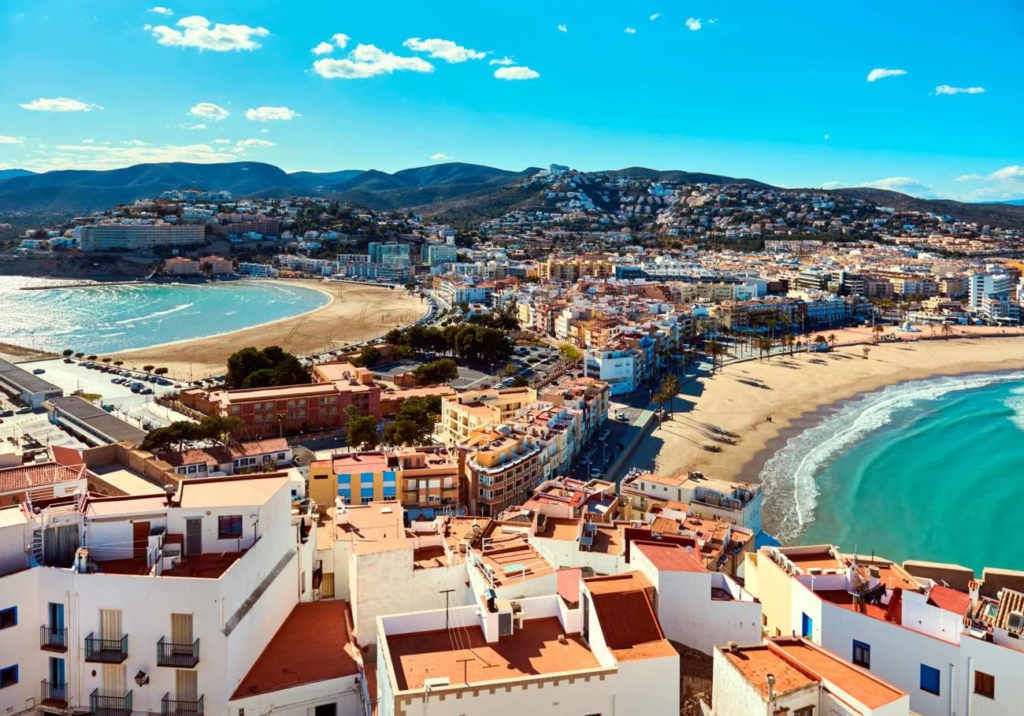Cortegada is a lesser-known destination on the Galician coast that captivates visitors with its untouched natural beauty, rich cultural history, and sense of timeless serenity. This enchanting island belongs to the Atlantic Islands of Galicia National Park, a protected archipelago revered for its pristine landscapes and thriving ecosystems. In this comprehensive guide, you will discover why Cortegada deserves a spot on your travel itinerary. You will also learn how to get there, what to see, and how to make the most of your visit. Let’s explore this hidden gem step by step.

Why Visit Cortegada Island?
Cortegada Island is a paradise for nature lovers. It stands out for having one of the largest laurel forests in Europe. This evergreen canopy is a spectacular sight. The laurel trees sway with the ocean breeze, creating a unique atmosphere of tranquility. Birdwatchers also flock here to admire the diverse avian population, which finds refuge among the island’s protected woodlands.
The island’s unspoiled scenery appeals to those who crave a break from busy tourist destinations. Cortegada has a quiet and off-the-beaten-path feel. You can stroll along secluded trails without encountering any crowds. This sense of peace allows you to connect more deeply with nature and enjoy an authentic Galician coastal experience.
Brief History and Cultural Significance
Cortegada Island has a captivating past that adds depth to its charm. Archaeological findings reveal that human settlements existed here for centuries. Residents built a small village and a chapel. Over time, these locals left the island due to changing economic conditions.
Though the island is no longer inhabited, you can still see remnants of its old stone houses. These structures blend seamlessly with the lush surroundings, creating a delightful setting for exploration. The chapel, dedicated to the Virgin of the Miraculous (Virxe da Miragrosa), once attracted pilgrims from across the region. Its ruins stand as a testament to the island’s religious heritage.
How to Get to Cortegada
Arriving in Galicia
Most travelers start their journey in Santiago de Compostela or Vigo. Both cities have well-connected airports and efficient public transportation. From Santiago de Compostela, you can catch a bus or train to Vilagarcía de Arousa or nearby coastal towns. Vigo also provides similar routes that lead to the Ría de Arousa area.
Reaching the Island
Cortegada lies off the coast of Carril, a small fishing village in the municipality of Vilagarcía de Arousa. Several local boat operators offer guided trips to the island, typically departing from Carril’s port. These boat tours last around 15–30 minutes and give you a scenic introduction to the Ría de Arousa. Schedules may vary, so booking in advance is wise. If you join a guided tour, you’ll learn about the island’s history, flora, and fauna.
Top Attractions and Activities on Cortegada
Explore the Laurel Forest
The laurel forest is the island’s main attraction. It is considered one of the most significant laurel groves in Europe. As you wander under the shady canopy, you’ll notice how dense and lush the vegetation is. The forest’s earthy scents combine with the crisp sea air, creating a memorable sensory experience. Keep an eye out for wildflowers and mossy rocks that decorate the forest floor.
Birdwatching Opportunities
Cortegada is home to a diverse population of birds. Gulls and herons are common sightings. At low tide, wading birds feast on shellfish along the island’s shore. Nature enthusiasts can bring binoculars to spot rarer species resting in the high branches or skimming over the water. This birdlife thrives due to the island’s protected status and absence of heavy tourism.
Ruins of Old Village and Chapel
Remnants of small stone houses tell the island’s story. These buildings are surrounded by greenery, giving them a magical and almost mythical appeal. The chapel ruins, dedicated to the Virgin of the Miraculous, are worth a visit. Though the structure is modest, it carries spiritual significance. Many pilgrims once journeyed to Cortegada for blessings and miracles.
Hiking Trails and Guided Walks
You can explore several short trails that meander through the forest and along the coastline. These paths are not strenuous, making Cortegada a family-friendly destination. A guided walk can enrich your visit, as local experts share folklore and environmental details. Remember to wear comfortable shoes. The terrain can be uneven in places.
Practical Travel Tips
Plan your visit for spring or summer. The weather is mild, and boat services run more frequently. Summers in Galicia offer pleasant temperatures and longer days to explore.
Wear appropriate footwear. Paths can be damp, especially after rainfall. Bring sturdy shoes or hiking boots to prevent slips and falls.
Carry enough water and snacks. There are no shops on the island. You should arrive prepared with sufficient drinks and light meals.
Check tide schedules. Low tide affects boat landings and reveals intertidal zones full of marine life. High tide changes the island’s silhouette.
Be respectful of conservation rules. Since Cortegada is part of the Atlantic Islands of Galicia National Park, it follows strict environmental regulations. Follow designated paths and avoid littering.
Cuisine Near Cortegada
Seafood Delights
Galician cuisine shines when it comes to seafood. After a trip to Cortegada, many visitors head to Carril or Vilagarcía de Arousa. These towns are famous for fresh clams, octopus, and razor clams (navajas). Restaurants serve these delicacies with simple yet flavorful recipes that highlight natural tastes.
Local Favorites
Pulpo a la Gallega (Galician-Style Octopus): This dish features tender octopus slices seasoned with olive oil, sea salt, and paprika. It’s a regional highlight.
Empanada Gallega: A savory pastry filled with fish, meat, or vegetables. The crust is flaky, and the filling bursts with flavor.
Arroz de Marisco (Seafood Rice): A comforting dish that blends rice with shrimp, clams, mussels, and vegetables. Many places add a hint of saffron.
Where to Eat
Carril’s waterfront has quaint seafood restaurants offering views of the estuary. Vilagarcía de Arousa, just a short distance away, also has a wide range of dining options. Freshness is key, so look for establishments that take pride in sourcing local catches. Pair your meal with a glass of Albariño wine for the perfect accompaniment to your seafood feast.
Where to Stay
Cortegada does not offer overnight accommodations because it is a protected island. However, neighboring towns provide a variety of lodging options:
Hotels in Vilagarcía de Arousa: You’ll find comfortable hotels close to the port, shopping areas, and cultural spots.
Rural Guesthouses: For a more intimate experience, consider a casa rural in the surrounding countryside. These cozy accommodations often feature stone-built homes and charming landscapes.
Vacation Rentals: If you prefer extra privacy and flexibility, look for vacation rentals near the coast. You can find modern apartments or traditional Galician cottages (pazos).
Day Trips and Nearby Attractions
Ría de Arousa Coastal Villages
The Ría de Arousa is dotted with picturesque fishing villages. Carril, Vilanova de Arousa, and Cambados each have unique identities. You can hop between them for a relaxed day of sightseeing. Sample local wines, shop for artisanal goods, or stroll through cobblestone streets that date back centuries.
Atlantic Islands of Galicia National Park
If you enjoy Cortegada, consider visiting other islands in the national park, such as Cíes or Ons. These islands offer stunning beaches, dramatic cliffs, and rich biodiversity. Access is controlled to preserve their delicate ecosystems. Booking in advance is wise, especially in summer.
Cultural Excursions
Galicia has a wealth of cultural attractions. The city of Pontevedra is famous for its pedestrian-friendly historic center. Santiago de Compostela, a UNESCO World Heritage Site, is the end of the Camino de Santiago. Spend a day exploring its magnificent cathedral and lively plazas.
Sustainability and Ecotourism
Cortegada thrives as a conservation success story. Authorities protect it under the Atlantic Islands of Galicia National Park regulations. Ecotourism efforts aim to preserve its delicate ecosystems while allowing visitors to appreciate the island’s beauty. Boats operate responsibly, limiting pollution and controlling visitor numbers. As a traveler, you play a part in keeping Cortegada pristine. By following park rules, respecting wildlife, and leaving no trace, you contribute to the island’s future.
FAQs about Cortegada
1. Do I need a special permit to visit Cortegada?
Usually, you don’t need a specific permit to visit Cortegada on a day trip. However, guided tours must respect park regulations regarding visitor numbers and environmental impact. It’s best to book through a licensed operator who handles the necessary arrangements.
2. How long does a typical visit last?
A typical visit lasts around two to three hours. This timeframe includes a guided walk through the laurel forest, time to explore ruins, and opportunities for birdwatching. Some tours provide extended visits for those who wish to savor the island’s serenity.
3. Can I visit Cortegada all year round?
You can visit year-round, but most boat operators run more frequent services from spring to early autumn. Weather conditions in fall and winter may affect boat departures. Always check the forecast and operating hours in advance.
4. What should I wear or pack for the trip?
Wear comfortable, sturdy shoes suitable for hiking on damp terrain. Bring a light jacket or sweater. Galicia’s coastal weather can change quickly. Pack water, snacks, and a camera to capture the island’s natural splendor.
5. Is there any accommodation on the island itself?
No. There are no hotels or guesthouses on Cortegada. The island remains uninhabited and protected. Stay in the nearby towns of Carril or Vilagarcía de Arousa for quick access to boat tours.
6. Is Cortegada family-friendly?
Yes. The island is suitable for families who enjoy nature and light hiking. Children can learn about local wildlife and history while exploring the forest trails. Keep a watchful eye on younger kids near the shoreline, especially at low tide.
7. Are pets allowed on the island?
Regulations usually prohibit pets to protect native fauna and flora. Check with local tour operators or park authorities before planning a trip with your pet.
Conclusion
Cortegada offers a one-of-a-kind experience that blends natural wonders, cultural heritage, and quiet reflection. Its laurel forest is a living testament to Galicia’s lush coastal environment. The island’s ruins reveal glimpses of a simpler past. Birdsong echoes through the trees, reminding visitors that this place remains a sanctuary for wildlife. Cortegada is a hidden paradise that stands apart from more crowded tourist spots.
By planning a trip to Cortegada, you support local ecotourism efforts. You also gain lasting memories of a place where time seems to stand still. After exploring the island, enjoy fresh seafood and Albariño wine in the nearby fishing villages. Take in stunning views across the Ría de Arousa. Finally, remember to respect the island’s fragile ecosystems. Your contribution ensures that Cortegada will continue to enchant visitors for generations to come.
Embark on this adventure to discover the soul of Galicia’s Atlantic Islands. Let Cortegada’s serene forests and ancient chapels draw you in. The experience promises a deep connection with nature and an authentic taste of local life. When you visit Cortegada, you’ll understand why this small island has captured the hearts of those who venture there. It is Galicia’s hidden gem, waiting for you to explore.

